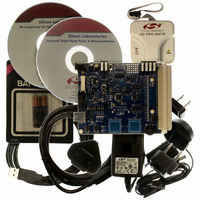C8051F930DK Silicon Laboratories Inc, C8051F930DK Datasheet - Page 134

C8051F930DK
Manufacturer Part Number
C8051F930DK
Description
KIT DEV C8051F920,F921,F930,F931
Manufacturer
Silicon Laboratories Inc
Type
MCUr
Specifications of C8051F930DK
Contents
Target Board, Power Adapter, USB Debug Adapter, Cables, Batteries, and Software
Processor To Be Evaluated
C8051F930
Processor Series
C8051F9xx
Data Bus Width
8 bit
Interface Type
I2C, UART, SPI
Maximum Operating Temperature
+ 85 C
Minimum Operating Temperature
- 40 C
Operating Supply Voltage
0.9 V to 3.6 V
Lead Free Status / RoHS Status
Lead free / RoHS Compliant
For Use With/related Products
C8051F920, F921, F930, F931
Lead Free Status / Rohs Status
Lead free / RoHS Compliant
Other names
336-1473
Available stocks
Company
Part Number
Manufacturer
Quantity
Price
Company:
Part Number:
C8051F930DK
Manufacturer:
Silicon Labs
Quantity:
135
- Current page: 134 of 324
- Download datasheet (3Mb)
C8051F93x-C8051F92x
12.3. Interrupt Priorities
Each interrupt source can be individually programmed to one of two priority levels: low or high. A low prior-
ity interrupt service routine can be preempted by a high priority interrupt. A high priority interrupt cannot be
preempted. If a high priority interrupt preempts a low priority interrupt, the low priority interrupt will finish
execution after the high priority interrupt completes. Each interrupt has an associated interrupt priority bit in
in the Interrupt Priority and Extended Interrupt Priority registers used to configure its priority level. Low pri-
ority is the default.
If two interrupts are recognized simultaneously, the interrupt with the higher priority is serviced first. If both
interrupts have the same priority level, a fixed priority order is used to arbitrate. See Table 12.1 on
page 135 to determine the fixed priority order used to arbitrate between simultaneously recognized inter-
rupts.
12.4. Interrupt Latency
Interrupt response time depends on the state of the CPU when the interrupt occurs. Pending interrupts are
sampled and priority decoded each system clock cycle. Therefore, the fastest possible response time is 7
system clock cycles: 1 clock cycle to detect the interrupt, 1 clock cycle to execute a single instruction, and
5 clock cycles to complete the LCALL to the ISR. If an interrupt is pending when a RETI is executed, a sin-
gle instruction is executed before an LCALL is made to service the pending interrupt. Therefore, the maxi-
mum response time for an interrupt (when no other interrupt is currently being serviced or the new interrupt
is of greater priority) occurs when the CPU is performing an RETI instruction followed by a DIV as the next
instruction. In this case, the response time is 19 system clock cycles: 1 clock cycle to detect the interrupt,
5 clock cycles to execute the RETI, 8 clock cycles to complete the DIV instruction and 5 clock cycles to exe-
cute the LCALL to the ISR. If the CPU is executing an ISR for an interrupt with equal or higher priority, the
new interrupt will not be serviced until the current ISR completes, including the RETI and following instruc-
tion.
134
Rev. 1.1
Related parts for C8051F930DK
Image
Part Number
Description
Manufacturer
Datasheet
Request
R
Part Number:
Description:
SMD/C°/SINGLE-ENDED OUTPUT SILICON OSCILLATOR
Manufacturer:
Silicon Laboratories Inc
Part Number:
Description:
Manufacturer:
Silicon Laboratories Inc
Datasheet:
Part Number:
Description:
N/A N/A/SI4010 AES KEYFOB DEMO WITH LCD RX
Manufacturer:
Silicon Laboratories Inc
Datasheet:
Part Number:
Description:
N/A N/A/SI4010 SIMPLIFIED KEY FOB DEMO WITH LED RX
Manufacturer:
Silicon Laboratories Inc
Datasheet:
Part Number:
Description:
N/A/-40 TO 85 OC/EZLINK MODULE; F930/4432 HIGH BAND (REV E/B1)
Manufacturer:
Silicon Laboratories Inc
Part Number:
Description:
EZLink Module; F930/4432 Low Band (rev e/B1)
Manufacturer:
Silicon Laboratories Inc
Part Number:
Description:
I°/4460 10 DBM RADIO TEST CARD 434 MHZ
Manufacturer:
Silicon Laboratories Inc
Part Number:
Description:
I°/4461 14 DBM RADIO TEST CARD 868 MHZ
Manufacturer:
Silicon Laboratories Inc
Part Number:
Description:
I°/4463 20 DBM RFSWITCH RADIO TEST CARD 460 MHZ
Manufacturer:
Silicon Laboratories Inc
Part Number:
Description:
I°/4463 20 DBM RADIO TEST CARD 868 MHZ
Manufacturer:
Silicon Laboratories Inc
Part Number:
Description:
I°/4463 27 DBM RADIO TEST CARD 868 MHZ
Manufacturer:
Silicon Laboratories Inc
Part Number:
Description:
I°/4463 SKYWORKS 30 DBM RADIO TEST CARD 915 MHZ
Manufacturer:
Silicon Laboratories Inc
Part Number:
Description:
N/A N/A/-40 TO 85 OC/4463 RFMD 30 DBM RADIO TEST CARD 915 MHZ
Manufacturer:
Silicon Laboratories Inc
Part Number:
Description:
I°/4463 20 DBM RADIO TEST CARD 169 MHZ
Manufacturer:
Silicon Laboratories Inc











